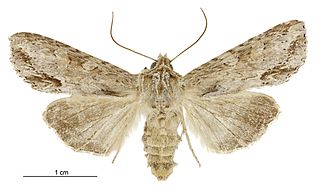
Ichneutica mollis is a moth of the family Noctuidae. It is endemic to New Zealand and is found from the Coromandel peninsular and Mount Te Aroha southwards including in the South and Stewart Islands. It lives in a variety of habitats including mountainous beech forest, podocarp forest and also grasslands. The larvae feed on grasses and herbs. The adults of this species are on the wing from October to March and are attracted to light and feed on blossoms.

Ichneutica pelanodes is a moth of the family Noctuidae. It is endemic to New Zealand and has been found in scattered locations in the North, South and Stewart Islands. I. pelanodes is easily confused with I. skelloni as the two species are visually extremely similar. In the North Island though the range of the two species appears not to overlap. Generally of the two species I. pelanodes tends to be darker in appearance. I. pelanodes inhabits wetlands but the life history of this species is unknown as are the host species of its larvae. Adults are on the wing from October to February and are attracted both to sugar and light traps.

Ichneutica petrograpta is a moth of the family Noctuidae. This species is endemic to New Zealand where it is found in the southwest districts of the South Island, including Westland, Otago Lakes and Fiordland. It is very similar in appearance to I. mutans. It inhabits tussock and shrubland in the alpine to subalpine zones. Adults of I. petrograpta are on the wing from December to February and are attracted to sugar traps. The life history of this species is unknown as are the host species of its larvae.

Ichneutica oliveri is a moth of the family Noctuidae. It is endemic to New Zealand, found only in the South Island. However it has not been observed on the eastern side of that island from mid-Canterbury southwards to Southland. This species is distinctive and is unlikely to be confused with other closely related species. It inhabits tussock grasslands, shrubland as well as granite sand plains, all in the alpine zone. Adults are on the wing from December to March and are attracted to light. They have been observed feeding on the flowers of Hebe species. The life history of this species is unknown as are the larval hosts.

Ichneutica scutata is a moth of the family Noctuidae. It is endemic to New Zealand. This species can be found in the southern parts of the North Island as well as the eastern parts of the South Island. It is similar in appearance to I. insignis and I. skelloni but can be distinguished as I. scutata is much paler in appearance. It is likely this species inhabits lowland tussock grasslands as well as coastal dunes although it is not common in inland tussock grasslands. The larvae feed on a variety of herbaceous plants such as Plantago and Convolvulus species, Plagianthus divaricatus. It pupates on soil near its host plants. The adults are on the wing from late March to July.
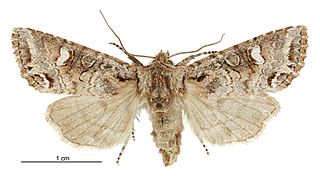
Ichneutica sericata is a moth of the family Noctuidae. It is endemic to New Zealand. This species is variable and difficult to distinguish from I. skelloni specimens. It is known from the southern part of the South Island and from Stewart Island. There has been one specimen collected in Taranaki but although Robert Hoare determined the species, he expressed reservations given the location of collection. I. sercata inhabits shrubland at altitudes of between 470 and 900m. The life history of this species is unknown as are the host species of its larvae. The adults of this species are on the wing in August at Stewart Island and in November and December in the South Island.
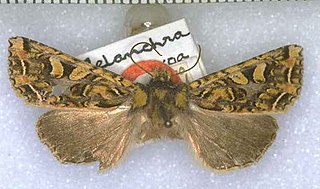
Meterana tetrachroa is a species of moth of the family Noctuidae. This species is endemic to New Zealand. It is classified as "Data Deficient" by the Department of Conservation.
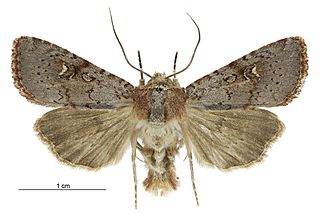
Ichneutica hartii is a moth of the family Noctuidae. This species is endemic to New Zealand and can be found only in the North Island. I. hartii is similar in appearance to Ichneutica agrorastis but can be distinguished as it tends to be smaller in size and have a more purplish shade to its fore wings. I. hartii tends to be found inhabiting lowland native forest or forests found in the hilly ranges of the North Island. It is attracted to light and the adults of this moth are on the wing between January and March. Much of its life history is currently unknown as are the larvae host species.
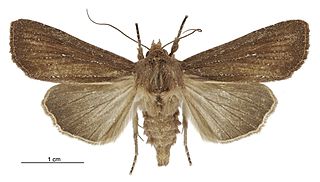
Ichneutica micrastra is a moth of the family Noctuidae. It is endemic to New Zealand. This species has been found only in the North Island and has been collected in the Northland, Auckland, Whanganui and Wellington regions. The preferred habitat of this species is wetlands and heathlands including gum fields in Northland. Adults of this species are on the wing from October to December. The life history of this species is unknown as are the host species of its larvae however it has been hypothesised that the likely larval host is a grass or grass like plant. This species is very similar in appearance to I. phaula and I. sapiens but can be distinguished as a result of differences in male antennae, the shape, colour and size of forewings, the range of the species as well as differences in genital shape.

Ichneutica paraxysta is a moth of the family Noctuidae. It is endemic to New Zealand. This species is very similar in appearance to its close relative I. acontistis but as the range of the two species do not overlap this is unlikely to cause confusion. I. paraxysta is only found in the North Island at the subalpine zones in the Mount Taranaki region and at Mount Ruapehu. It prefers tussock grassland and shrubland habitat. The life history of this species is unknown as are the host species of its larvae however it has been hypothesised that the larval host plants are species in the genera of Poa and Festuca.

Ichneutica fibriata is a moth in the family Noctuidae. It is endemic to New Zealand. Specimens of this moth were first collected by Frederick Giles Gibbs. The species is similar in appearance to other species in the Ichneutica genus particularly I. eris but can be distinguished due to its larger size and more uniform light grey colour. I. fibriata also has a similar coloured thorax and head where as these two anatomical features may differ in colour shade in I. eris. Adults frequent alpine areas and are on the wing in November to January. The life history and the host species of the larvae of this species is unknown.

Ichneutica panda is a species of moth in the family Noctuidae. It is endemic to New Zealand and only found in central and southern parts of the South Island. The species has not been collected in Canterbury since the late 1950s and has not been seen at The Wilderness scientific reserve since 1941. This species is similar in appearance to Ichneutica falsidica however I. panda lack or have indistinct black dashes on their edge of their hindwings. I. panda inhabit shrubland from alpine zones down to river terraces and adults are on the wing between December to February. The life history of this species is unknown as is the host species of the larvae.

Ichneutica falsidica is a moth of the family Noctuidae. This species is endemic to New Zealand and is widespread in the South Island but can only be found in the Tararua Range and Mount Taranaki in the North Island. This species is similar looking to I. panda but I. falsidica has dark dashes on their hind-wings. This species can be found open high country and has been seen flying during the day in sunny warm weather. At night adults are attracted to light. The life history of this species is unknown as are the host species of the larvae.
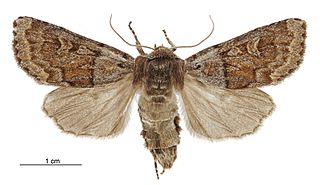
Ichneutica marmorata is a moth of the family Noctuidae. This species is endemic to New Zealand and can be found in the North Island at the Tongariro National Park and at Puketitiri near the Kaweka Range. In the South Island it is widespread. It prefers alpine to subalpine habitat but occurs down to sea level altitudes in more southern locations. Adults are on the wing from late October to February. Larvae of this species may use tussock grasses in the genus Chionochloa as their host and they have been reared on Festuca novae-zelandiae.
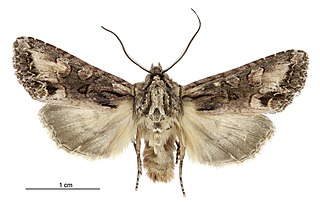
Ichneutica bromias is a moth of the family Noctuidae. This species is endemic to the Chatham Islands of New Zealand where is found on the Chatham, Pitt and Rangatira Islands. This species is similar in appearance to Ichneutica mutans but is darker and duller in its overall appearance. However, as I. mutans is not present in the Chathams this similarity is unlikely to cause confusion. The adults of the species are on the wing from November to March. The life history and the larval host species are unknown.
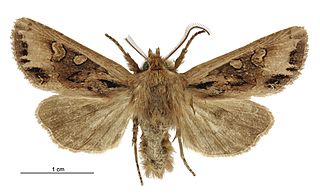
Ichneutica fenwicki is a moth of the family Noctuidae. This species is endemic to New Zealand and is found in the southern parts of the South Island and on Stewart Island. It is a distinctively coloured moth that is unlikely to be confused with closely related species. It is a spring flying moth being on the wing from September to November. The life history and host species of the larvae of I. fenwicki are unknown.
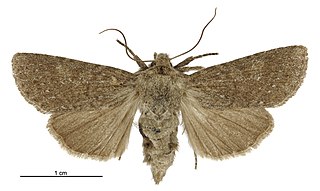
Ichneutica sollennis is a moth of the family Noctuidae. This species is endemic to New Zealand. This species is known from the eastern and central areas of the southern South Island. It inhabits alpine zones and has been collected in tussock grasslands. The life history of this species is unknown. Although the host species is currently unknown it has been hypothesised that this species have grass or grass like plants as host plants. Adults are on the wing from November to February and are attracted to light.
Ichneutica sapiens is a moth of the family Noctuidae. This species is endemic to New Zealand. I. sapiens is found in the central North Island, in the South Island in Westland and also the southern parts of the South Island, and in Stewart Island. This species inhabits wetland habitat but its life history is unknown as are the host species of its larvae. The adult moths are on the wing between December to early January and are attracted to sugar traps and to light. I. sapiens is very similar in appearance to I. micrastra but is a smaller moth with a shorter wingspan, has differently formed antennae and slightly different forewing markings.
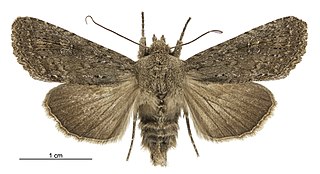
Physetica homoscia is a species of moth of the family Noctuidae. It is endemic to New Zealand and is found throughout New Zealand including in the Auckland Islands. This species inhabits places where its host plants are common and this includes costal dune habitat. It lives at a wide range of altitudes from sea-level up to at least 1750 m. The larvae of P. homoscia feed on Ozothamnus leptophyllus and Ozothamnus vauvilliersii. They are very active and drop to the ground when disturbed. Larvae are parasitised by a species of fly. This species pupates in the soil and the pupa life stage lasts for approximately 6 weeks. The adult moths are on the wing from September to June and are attracted to light. The adults of P. homoscia might possibly be confused with Ichneutica moderata however this latter species lacks the small white dots on the forewing veins of P. homoscia. Adults might also be confused with P. temperata but P. homoscia is significantly larger in size.
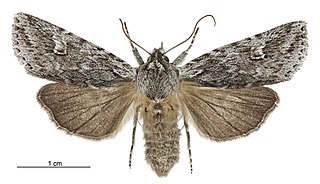
Physetica sequens is a species of moth of the family Noctuidae. It is endemic to New Zealand and can be found throughout the North and South Islands. It appears to be more common in the North Island than the South Island, and lives in open native shrublands, peatlands, Northland gumland, inland volcanic dunes, and Dracophyllum-dominated areas at altitudes that range from sea level to the alpine zone, up to at least 1600 m. Larvae of this species have been successfully reared on Leucopogon fasciculatus and Leptecophylla juniperina. The adults of this species are variable in appearance and are on the wing from September to March. P. sequens is similar in appearance to P. phricias but can be distinguished as P. phricias has a narrow black line along the dorsum of its forewing that P. sequens does not. P. sequens is also similar in appearance to P. cucullina however the forewing dorsum area of P. sequens does not have the narrow black line that is frequently present on P. cucullina forewings.




















